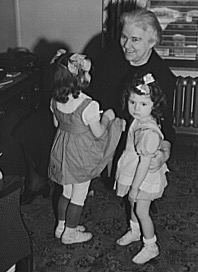In the second of our Disability History Month Snapshots, Dr. Stephen Mawdsley discusses Sister Elizabeth Kenny and the Transformation of Paralytic Polio Treatment in 1940s America.
Australian nurse Sister Elizabeth Kenny reformed polio treatment in America. Poliomyelitis (polio) is caused by a contagious viral disease that attacks the motor neurons of the spinal cord, which can lead to paralysis of the limbs and respiratory muscles and, in some cases, death. Until a safe and effective vaccine was licensed in 1955, many Americans lived in fear of recurring epidemics. Before the 1940s, most medical treatments for paralytic polio were rudimentary and based on limb immobilization and surgery. Such methods were expensive, painful, and often provided limited effectiveness.

Minneapolis, Minnesota. Sister Kenny with Winifred Gorman (right), an infantile paralysis patient, and Winifred’s sister who has come to the Elizabeth Kenny Institute to see her on visitor’s day. By Jack Delano, 1943, Library of Congress, U.S. Farm Security Administration/Office of War Information Black & White Photographs
Medical orthodoxy in America was challenged by Sister Kenny, who had previously devised an approach for treating polio based on experience tending to patients in remote regions of Australia during the 1930s. She devised a method that rejected limb immobilization; instead, it employed massage, physical therapy, and hot wool compresses applied to afflicted limbs to reduce spasms and muscle atrophy. Survivor accounts from the period often describe the smell of hot wool and the feeling of the compresses on the skin.
American physicians were initially unconvinced by Kenny and her method because it challenged decades of precedent. Nevertheless, her approach to polio treatment prevailed due to her dedication, philanthropic alliances, and evidence base. With the assistance of America’s foremost polio charity, the National Foundation for Infantile Paralysis (March of Dimes), Kenny established a professional training and treatment centre to disseminate her method across America. She traveled widely and later expanded the initiative through the establishment of the Sister Kenny Foundation. Kenny’s method proved to be an important milestone in the treatment of polio paralysis and showed the value of therapeutic innovation.
Further reading: Naomi Rogers, Polio Wars: Sister Kenny and the Golden Age of American Medicine (Oxford, 2014).
